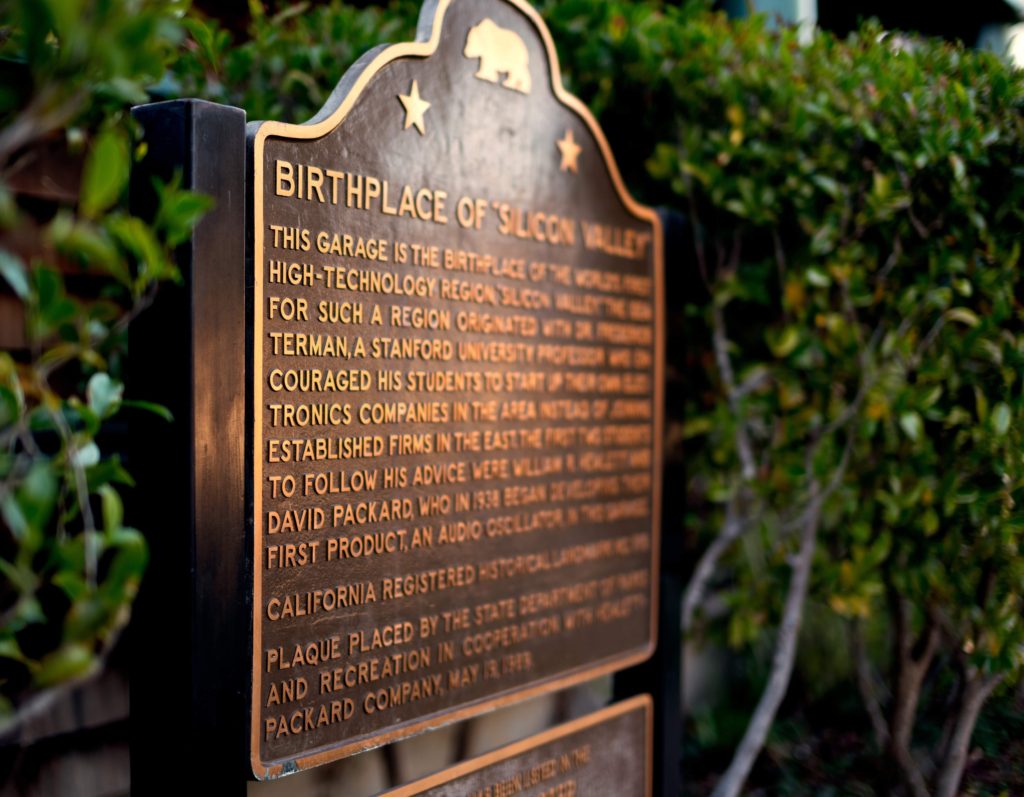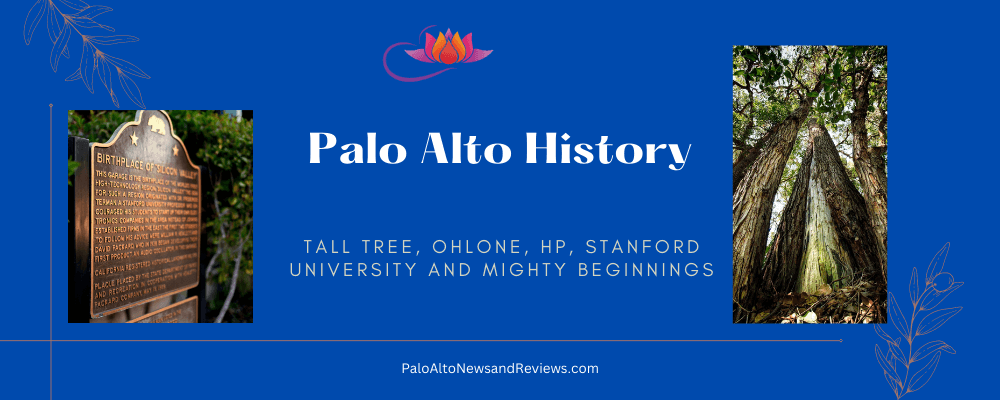Palo Alto is a city located in the northwest corner of Santa Clara County, California. The city is named after a majestic tree known as the El Palo Alto, which stands on the banks of the San Francisquito Creek. The name ‘Palo Alto’ is Spanish for ‘tall tree’, which accurately describes the magnificent specimen that still stands today. It’s about 45 minutes south of San Francisco along the popular CalTrans train map or US 101.
The land where the city now sits was originally inhabited by the Ohlone people, who lived in the area for thousands of years before the arrival of Europeans. In 1769, a Spanish expedition led by Gaspar de Portolá and Father Junipero Serra reached the area while exploring the California coast. The expedition camped near the San Francisquito Creek, and it was here that the El Palo Alto tree caught their attention. The tree was already a well-known landmark for the Ohlone people, who held it in high esteem for its medicinal properties.
In 1822, Mexico gained its independence from Spain and California became a part of Mexico. The area that now includes Palo Alto was granted to a Mexican soldier named Luis Galindo. Galindo never lived on the land, and it eventually passed to a businessman named Thomas Welton Stanford, the brother of Leland Stanford.
In 1885, Leland Stanford, a former Governor of California and co-founder of Stanford University, founded the city of Palo Alto as part of his vision for a grand university campus. He had originally wanted the university to be located in San Francisco, but after the city was devastated by the 1906 earthquake, he decided to build it in Palo Alto instead.
Palo Alto has a rich history that is closely tied to Leland Stanford and the university that bears his name. In the mid-19th century, the area that is now Palo Alto was sparsely populated and primarily used for ranching and farming. However, that all changed with the arrival of Leland Stanford and his wife Jane.

Leland Stanford was a prominent businessman and politician in California during the mid-1800s. He made his fortune in the railroad industry and was elected governor of California in 1861. Tragedy struck in 1884 when his son, Leland Jr., died from typhoid fever at the age of 15. In honor of his son, Leland and Jane Stanford decided to establish a university that would provide a world-class education to young people in California.
After purchasing a large parcel of land in the Santa Clara Valley, the Stanfords began the process of creating their new university. The site they chose was located just a few miles from the town of Mayfield, which would later become Palo Alto. The Stanfords were impressed by the area’s natural beauty, which included a grove of tall trees and a gentle slope that offered views of the surrounding hills.
In 1887, the Stanfords broke ground on their new university, which was named after their son. Construction of the campus proceeded quickly, and by 1891, the first classes were being held at Stanford University. The campus was designed by Frederick Law Olmsted, the renowned landscape architect who had also designed New York City’s Central Park. Olmsted’s plan for Stanford University included a central quadrangle, with academic and administrative buildings arranged around a central lawn.
As the university grew, so too did the town of Palo Alto. In 1892, the town was incorporated, and by 1900, it had a population of nearly 1,500 people. Many of the town’s early residents were faculty and staff members at Stanford University, and the two communities were closely intertwined. Over the years, the town and the university continued to grow and prosper together, with each benefiting from the other’s presence.
The city of Palo Alto was officially incorporated in 1894, and it quickly became a hub for technological innovation. In 1909, the world’s first radio station, KQW (now known as KCBS), began broadcasting from Palo Alto. Hewlett-Packard, one of the world’s most iconic technology companies, was founded in a Palo Alto garage in 1939. Other notable companies that have called Palo Alto home include Tesla, Skype, and PayPal.
Hewlett-Packard (HP) is a technology company that has played a significant role in the evolution of the computer industry. The company was founded in 1939 by two friends, William Hewlett and David Packard, in a garage on Addison Avenue in Palo Alto, California. The garage is now a famous historical landmark and is considered the birthplace of Silicon Valley. (Special note: the author of this website grew up on Addison Avenue, attending Addison Elementary, Jordan Jr High and Palo Alto High School).

and David Packard started a revolution of sorts.
The history of Palo Alto is intertwined with the history of the company Hewlett-Packard. Both founder families have since built exceptional family foundations responsible for millions of dollars of philanthropic giving in the greater region.
William Hewlett and David Packard were both Stanford graduates with a passion for electronics. They met while working on a project for a professor at Stanford and quickly became friends. After graduation, they decided to start their own company, which they named Hewlett-Packard. The company’s first product was an audio oscillator, which they sold to Disney for use in the production of the movie Fantasia.

The success of the audio oscillator led to more business for Hewlett-Packard, and the company continued to grow. In the 1950s, HP expanded into the computer industry, producing its first computer, the HP 2116A, in 1966. In the 1970s, HP began to focus more on personal computing. HP also became a leader in the printer industry with the introduction of the HP LaserJet printer in 1984.
In the 1990s, HP continued to expand into new areas of technology. The company entered the digital camera market with the introduction of the HP PhotoSmart in 1996. HP also acquired several companies, including Apollo Computer, Compaq Computer, and Indigo NV. The early 2000s saw significant changes for HP. In 2002, Carly Fiorina became the company’s CEO, becoming the first woman to lead a Fortune 20 company. Under her leadership, HP expanded into new areas, including the acquisition of software company Mercury Interactive in 2006.
In recent years, HP has continued to evolve and adapt to changes in the technology industry. In 2015, the company split into two separate entities: HP Inc. and Hewlett Packard Enterprise. HP Inc. focuses on personal computers and printers, while Hewlett Packard Enterprise focuses on servers, storage, and software.
Throughout its history, HP has remained committed to innovation and has played a significant role in the development of the computer industry. The company’s early years in the garage on Addison Avenue are a testament to the entrepreneurial spirit and creativity that continue to drive innovation in Silicon Valley and beyond.
Palo Alto has always been a progressive city, and it played an important role in the civil rights movement of the 1960s. In 1965, the city became the first in the country to pass a fair housing ordinance, which prohibited discrimination based on race, color, religion, national origin, or ancestry. The ordinance was met with fierce opposition from some residents, but it ultimately paved the way for fair housing laws across the country.
During the 1960s, the Civil Rights Movement was in full swing across the United States, and Palo Alto was no exception. The city was home to a vibrant community of activists, including students, professors, and community leaders who were committed to ending racial discrimination and segregation in all its forms.
One of the key events in the civil rights movement in Palo Alto was the 1964 protest at the city’s only movie theater, the Stanford Theatre. At the time, the theater only allowed white patrons to sit in the orchestra section, while black patrons were forced to sit in the balcony. This segregation was illegal, but it was still a common practice in many parts of the country.
A group of students from nearby Stanford University organized a sit-in at the theater to protest this discrimination. The protest was peaceful, but the students were arrested and charged with trespassing. The incident received national attention and helped to galvanize support for the civil rights movement in Palo Alto and beyond.
Another important moment in the city’s civil rights history came in 1965, when a group of black students at one of the city’s high schools, Palo Alto High School, organized a walkout to protest the lack of diversity and opportunities for black students. The students demanded that the school administration hire more black teachers, offer more courses on African American history and culture, and create a more welcoming and inclusive environment for black students.
The walkout was somewhat successful, and the school administration agreed to many of the students’ demands. The incident sparked a broader conversation about racial equity and representation in the city, and it helped to inspire similar actions in other parts of the country.
Today, Palo Alto is known for its thriving tech industry, its beautiful natural surroundings, and its commitment to sustainability and innovation. The housing prices are insanely high, with a small three-bedroom two-bath home under 1000 square feet fetching around $3 million. Renting in Palo Alto is also a challenge – be the first to arrive with a great rental resume if you’d like to rent a home in Palo Alto. With the beautiful weather, ambiance, lovely homes and gardens, parks and restaurants, Palo Alto is a destination city. Go for a day, you might want to stay.
